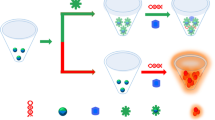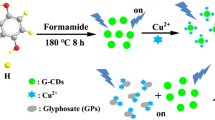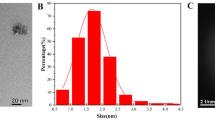Abstract
Glyphosate (Glyp) is an organophosphorus herbicide, and its abuse causes potential harm to the environment and human health. Thus, the development of simple and portable methods for rapid and visual detection of glyphosate is of great importance. Herein, we successfully developed a new fluorescent probe L with dansyl fluorophore as a fluorescent dye and tetrapeptide (Ala-Ser-Arg-His-NH2) as a recognition group. According to the design, L exhibited a specific fluorescence quenching response to Cu2+ and formed an L-Cu2+ ensemble with a molecular ratio of 2:1, demonstrating a limit of detection (LOD) as low as 12.04 nM. Interestingly, the L-Cu2+ ensemble as a relay response probe exhibited a specific fluorescence “off–on” response to glyphosate without interference from other pesticides and anions based on the strong complexation of glyphosate and Cu2+. The LOD of the L-Cu2+ ensemble for glyphosate was calculated as 12.59 nM. Additionally, the results of three recovery experiments with real samples showed that L has good practicability and accuracy in detecting glyphosate. Test strips were also fabricated to achieve facile detection of glyphosate to demonstrate the practical application potential of the L-Cu2+ ensemble. The L-Cu2+ ensemble was integrated with a smartphone for semi-quantification of glyphosate in a field environment under a 365 nm UV lamp.
Graphical abstract











Similar content being viewed by others
References
Woodburn AT. Glyphosate: production, pricing and use worldwide. Pest Manag Sci. 2000;56:309–12.
Duke SO, Powles SB. Glyphosate: a once-in-a-century herbicide. Pest Manag Sci. 2008;64:319–25.
Worek F, Thiermann H, Wille T. Organophosphorus compounds and oximes: a critical review. Arch Toxicol. 2020;94:2275–92.
Valle AL, Mello FCC, Alves-Balvedi RP, Rodrigues LP, Goulart LR. Glyphosate detection: methods, needs and challenges. Environ Chem Lett. 2019;17:291–317.
Benbrook CM. Trends in glyphosate herbicide use in the United States and globally. Environ Sci Eur. 2016;28:1–15.
Guyton KZ, Loomis D, Grosse Y, Ghissassi FE, Tallaa LB, Guha N, et al. Carcinogenicity of tetrachlorvinphos, parathion, malathion, diazinon, and glyphosate. Lancet Oncol. 2015;16:490–1.
Yang YY, Tong X, Chen YX, Zhou RR, Cai GH, Wang TT, et al. A dual-emission carbon dots-based nonenzymatic fluorescent sensing platform for simultaneous detection of parathion-methyl and glyphosate. Food Chem. 2023;403: 134346.
Chang YC, Lin YS, Xiao GT, Chiu TC, Hu CC. A highly selective and sensitive nanosensor for the detection of glyphosate. Talanta. 2016;161:94–8.
Fu Z, He JT, Li YM, Ding H, Gao XX, Cui FL. A novel and ultrasensitive fluorescent probe derived from labeled carbon dots for recognitions of copper ions and glyphosate. Spectrochim Acta Part A. 2023;287: 122052.
Wan CQ, Pang YH, Feng YW, Feng XF. A ratio fluorescence sensor based on rhodamine B embedded metal-organic framework for glyphosate detection in agri-food products. Food Chem. 2022;394: 133446.
Guyton KZ, Loomis D, Grosse Y, Ghissassi FE, Tallaa LB, Guha N, et al. International Agency for Research on Cancer Monograph Working Group, IARC, Lyon, France Carcinogenicity of tetrachlorvinphos, parathion, malathion, diazinon, and glyphosate. Lancet Oncol. 2015;16:490–1.
Yang YX, Ghalandari B, Lin LY, Sang X, Su WQ, Divsalar A, et al. A turn-on fluorescence sensor based on Cu2+ modulated DNA-templated silver nanoclusters for glyphosate detection and mechanism investigation. Food Chem. 2022;367: 130617.
Wei X, Gao X, Zhao L, Peng X, Zhou L, Wang J, et al. Fast and interference-free determination of glyphosate and glufosinate residues through electrophoresis in disposable microfluidic chips. J Chromatogr A. 2013;1281:148–54.
Zhang YY, Zhang Y, Qu QS, Wang GX, Wang CY. Determination of glyphosate and aminomethylphosphonic acid in soybean samples by high performance liquid chromatography using a novel fluorescent labeling reagent. Anal Methods. 2013;5:6465–72.
Zhang Q, Xu G, Gong L, Dai H, Zhang S, Li Y, et al. An enzyme-assisted electrochemiluminescent biosensor developed on order mesoporous carbons substrate for ultrasensitive glyphosate sensing. Electrochim Acta. 2015;186:624–30.
Prasad BB, Jauhari D, Tiwari MP. Doubly imprinted polymer nanofilm-modified electrochemical sensor for ultra-trace simultaneous analysis of glyphosate and glufosinate. Biosens Bioelectron. 2014;59:81–8.
Guo ZX, Cai QT, Yang ZG. Determination of glyphosate and phosphate in water by ion chromatography-inductively coupled plasma mass spectrometry detection. J Chromatogr A. 2005;1100:160–7.
Zhang W, Feng Y, Ma L, An J, Zhang H, Cao M, et al. A method for determining glyphosate and its metabolite aminomethyl phosphonic acid by gas chromatography-flame photometric detection. J Chromatogr A. 2019;1589:116–21.
Jung KH, Oh ET, Park HJ, Lee KH. Development of new peptide-based receptor of fluorescent probe with femtomolar affinity for Cu+ and detection of Cu+ in Golgi apparatus. Biosens Bioelectron. 2016;85:437–44.
Xiao L, Wei P, He F, Gou YT, Zhou J, Wang P, et al. Smartphone-assisted colorimetric and fluorescent dual-functional peptide-based probe for multianalyte visual detection in 100% aqueous media, living cells and test strips. J Mol Struct. 2023;1274: 134556.
Wei P, Xiao L, Gou YT, He F, Zhou DG, Liu Y, et al. Fluorescent “on-off-on” probe based on copper peptide backbone for specific detection of Cu(II) and hydrogen sulfide and its applications in cell imaging, real water samples and test strips. Microchem J. 2022;182: 107848.
Wang P, Xue SR, Chen B, Liao F. A novel peptide-based fluorescent probe for highly selective detection of mercury (II) ions in real water samples and living cells based on aggregation-induced emission effect. Anal Bioanal Chem. 2022;414:4717–26.
Lohani R, Neupane LN, Kim JM, Lee KH. Selectively and sensitively monitoring Hg2+ in aqueous buffer solutions with fluorescent sensors based on unnatural amino acids. Sensor Actuat B Chem. 2012;161:1088–96.
Wei P, Xiao L, Gou YT, He F, Wang P, Yang XP. A novel peptide-based relay fluorescent probe with a large Stokes shift for detection of Hg2+ and S2− in 100 % aqueous medium and living cells: Visual detection via test strips and smartphone. Spectrochim Acta Part A. 2023;285: 121836.
Wang QF, Guo ZQ, Zhou DG, Wu J, Wang P, Yang XP, et al. A novel fluorescent probe for highly selective and sensitive detection of sulfur ions in real samples and living cells based on the tripeptide-Cu2+ ensemble system. Microchem J. 2021;169: 106612.
Xiao L, Wei P, He F, Gou YT, Ge YS, Liu Y, et al. Peptide-based fluorescent and colorimetric dual-functional probe for visual detection of Cu2+, Hg2+ and S2− in 100% aqueous media, living cells and paper test strips. J Photochem Photobiol A. 2022;433: 114178.
Neupane LN, Hwang GW, Lee KH. Tuning of the selectivity of fluorescent peptidyl bioprobe using aggregation induced emission for heavy metal ions by buffering agents in 100% aqueous solutions. Biosens Bioelectron. 2017;92:179–85.
Wang P, Xue SR, Yang XP. Highly selective and sensitive detection of hydrogen sulfide in aqueous medium and live cells using peptide-based bioprobe to mimic the binding sites of the ceruloplasmin for Cu(II) ions. Biosens Bioelectron. 2020;163: 112283.
Wang P, Sun LY, Wu J, Yang XP, Lin PC, Wang M. A dual-functional colorimetric and fluorescent peptide-based probe for sequential detection of Cu2+ and S2− in 100% aqueous buffered solutions and living cells. J Hazard Mater. 2021;407: 124388.
Wang P, Zhou DG, Xue SR, Chen B, Wen SH, Yang XP, et al. Rational design of dual-functional peptide-based chemosensor for sequential detection of Ag+ (AgNPs) and S2− ions by fluorescent and colorimetric changes and its application in live cells, real water samples and test strips. Microchem J. 2022;177: 107326.
Xu JB, Liu N, Hao CW, Han QQ, Duan YL, Wu J. A novel fluorescence “on-off-on” peptide-based chemosensor for simultaneous detection of Cu2+, Ag+ and S2−. Sensors Actuators B Chem. 2019;280:129–37.
Hao CW, Guo XM, Lai Q, Li YX, Fan BM, Zeng GZ, et al. Peptide-based fluorescent chemical sensors for the specific detection of Cu2+ and S2−. Inorg Chim Acta. 2020;513: 119943.
Wang P, Xue SR, Zhou DG, Guo ZQ, Wang QF, Guo BX, et al. Peptide-based colorimetric and fluorescent dual-functional probe for sequential detection of copper(II) and cyanide ions and its application in real water samples, test strips and living cells. Spectrochim Acta Part A. 2022;276: 121222.
Clark M, Cramer RD III, Cramer NV III. Validation of the general purpose Tripos 5.2 force field. J Comp Chem. 1989;10:982–1012.
Humphrey W, Humphrey A, Schulten K. VMD: visual molecular dynamics. J Mol Graph Model. 1996;14:33–8.
Lee C, Yang W, Parr RG. Development of the Colle-Salvetti correlation-energy formula into a functional of the electron density. Phys Rev B. 1988;37:785–9.
Beck AD. Density-functional thermochemistry. I. The effect of the exchange-only gradient correction. J Chem Phys. 1993;98:5648–52.
Frisch MJ, Trucks GW, Schlegel HB, Scuseria GE, Robb MA, Cheeseman JR, et al. Gaussian 09, Revision A.01. Wallingford: Gaussian Inc.; 2009.
Zucchero AJ, McGrier PL, Bunz UHF. Cross-conjugated cruciform fluorophores. Acc Chem Res. 2010;43:397–408.
Acknowledgements
This work was supported by the National Natural Science Foundation of China (NO. 22206154), the Application Foundation Project of Science and Technology Department of Sichuan Province (NO. 2021YJ0409).
Author information
Authors and Affiliations
Corresponding author
Ethics declarations
Conflict of interest
The authors declare that there are no conflicts of interest with the content of this article.
Additional information
Publisher's note
Springer Nature remains neutral with regard to jurisdictional claims in published maps and institutional affiliations.
Supplementary Information
Below is the link to the electronic supplementary material.
Rights and permissions
Springer Nature or its licensor (e.g. a society or other partner) holds exclusive rights to this article under a publishing agreement with the author(s) or other rightsholder(s); author self-archiving of the accepted manuscript version of this article is solely governed by the terms of such publishing agreement and applicable law.
About this article
Cite this article
Wei, P., Xiao, L., Hou, P. et al. A novel Cu(II)-assisted peptide fluorescent probe for highly sensitive detection of glyphosate in real samples: real application in test strips and smartphone. Anal Bioanal Chem 415, 5985–5996 (2023). https://doi.org/10.1007/s00216-023-04869-3
Received:
Revised:
Accepted:
Published:
Issue Date:
DOI: https://doi.org/10.1007/s00216-023-04869-3




